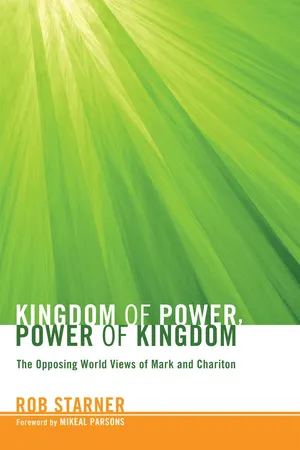![]()
1
Introduction
The disordered nature of the Gospel of Mark cannot be chronicled among the discoveries of modern literary inquiry. Indeed, as Eusebius’s quotation of Papias shows, awareness of disarrangement in Mark’s Gospel reaches back into history almost as far as the Gospel itself. Not surprisingly, therefore, the Gospel of Mark has presented a challenge to modern scholarship, which holds the systematization of data to be a sine qua non of critical research.
The apparently indiscriminate arrangement of Mark’s narrative material has given rise to numerous attempts to fit these materials into a logically structured grid. Joanna Dewey recently remarked: “Of making outlines of the Gospel of Mark there is no end, nor do scholars seem to be wearying of it. Yet we have been unable to agree on a structure or outline for Mark.” The variety and complexity of recent attempts to outline the Gospel of Mark is sufficient to illustrate the intricate nature of its structure.
This plethora of suggested outlines for Mark’s Gospel may be partially attributed to the disjunctures in the Gospel’s chronological scheme and the lack of temporal references from which a tenable historical sequence can be discerned. D. E. Nineham assesses the Markan materials in typical form-critical fashion. According to Nineham, Mark
Responding to C. H. Dodd’s argument that Mark relied on an outline of Jesus’ activity preserved by the early church, Nineham writes:
The jumbled temporal arrangement of the Markan materials has led some scholars to conclude that Mark’s Gospel “defies any definitive structural model.”
While Mark’s structural awkwardness has long been recognized, programmed analyses of this attribute have appeared only recently. Two such works especially important for the present context are H. A. Guy’s The Origin of the Gospel of Mark and John C. Meagher’s Clumsy Construction in Mark’s Gospel.
Guy and Meagher give impetus to the present investigation since both tend to view the Gospel as story and embrace a rather low assessment of Mark’s literary quality. Guy identifies various types of disorder in Mark, such as interruptions, repetitions, haphazard arrangement, and lack of topical or logical connection between successive statements. Meagher describes Mark’s literary character as “very ordinary, homely, untrained prose, full of the same stylistic sloppiness and clumsy mismanagement of basic storytelling techniques that one expects to find in unsophisticated writing. . . .”
Meagher extends his charge of negligent mishandling of the Gospel materials beyond the Gospel writer to the antecedent stages of the text’s production, namely, the oral transmission of the materials and the redaction that the materials underwent prior to being arranged in their final form. Denying the possibility of producing a precise history of forms and affirming the likelihood of inappropriate or mistaken contributions by redactors, he finds the assumptions and conclusions of both form and redaction criticism unacceptable.
Meagher succeeds in providing a model for understanding the transmission of oral materials and in demonstrating the weaknesses of form- and redaction-critical approaches. Nevertheless, he despairs of finding a more serviceable methodology. Thus, his work provides special motivation for this study; his negative assessment of past hermeneutical approaches and failure to offer a solution in their place issue a challenge to find legitimate procedures for reading Mark’s Gospel.
Justification for the Study
Jerry Camery-Hoggatt well illustrates a major weakness of methodologies that focus on extra-textual issues. He recounts a conversation with his preschool daughter in which she related her version of the story of “Little Red Riding Hood”—a version in which she added the qualifying words “biscuits and wine” to the “basket of goodies” in the original story. He describes his reactions:
“Los[ing] track of the story itself” is precisely what the discipline of narrative criticism seeks to avoid.
Historical questions related to a given text (e.g., sources, original audience, and setting) have their proper place. At issue, however, is the status of that place. Using history to elucidate the biblical text is always legitimate. But the same cannot be said of the converse, for supplying answers to historical inquiry is not the primary concern of the biblical writers. Referring to the Jesus-sayings material, Robert C. Tannehill rightly cautions:
The results of such approaches have lead Meagher to a conclusion that represents one way of dealing with the disordered nature of the Markan materials: attribute it to the ineptitude of the writer. Meagher is neither the only nor the first scholar to take such a despondent stance. Nevertheless, in the current trend of viewing the Gospels as intentional narrative constructions, Mark increasingly is being regarded as a writer of considerable literary acumen. This study seeks to demonstrate that attributing the narrative “disorder” to an intentional literary scheme offers a more fruitful way of dealing with the Markan materials.
Narrative-critical approaches that propose to look at the text for the ways it addresses its readers rather than through the text for primarily historical data represent a relatively recent phase in NT scholarship, a phase that has generated fresh, holistic views of the biblical narratives. Nevertheless, both the techniques by which the biblical narratives have been analyzed as well as the extra-biblical materials with which these biblical narratives have been compared have been drawn largely from the modern period. The legitimacy of such an approach is rightly being questioned.
In his 1989 survey of Markan scholarship, Larry Hurtado concludes: “there is increased emphasis that Mark should be analyzed in light of Jewish and pagan literary traditions of the Greco-Roman era.” Steven Sheeley stresses this same caveat in his treatment of the Gospel narrators. Commenting on the future of narrative-critical research, Sheeley admonishes:
